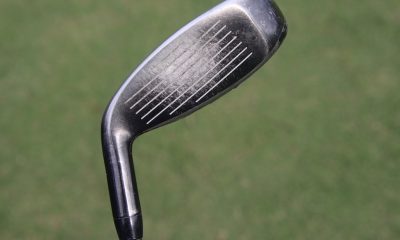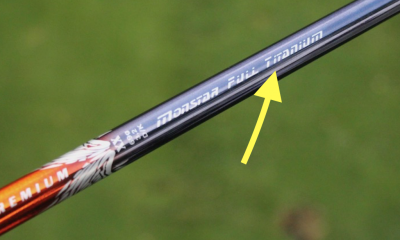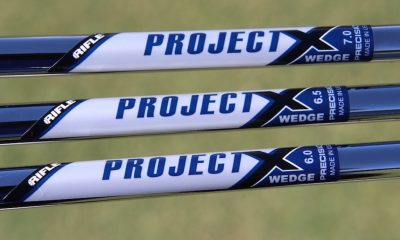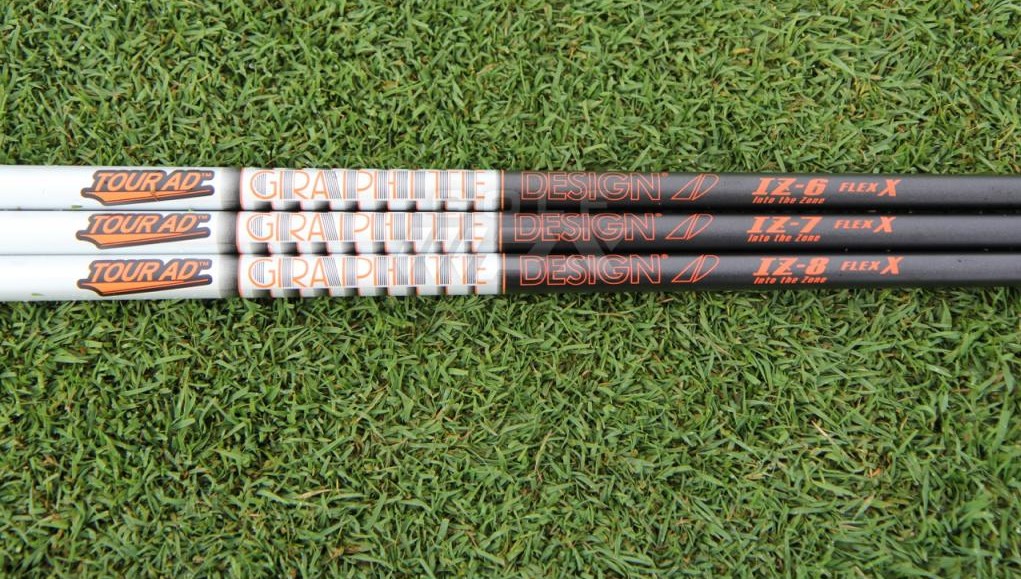Opinion & Analysis
Part 3: Facts about shafts, and what they do
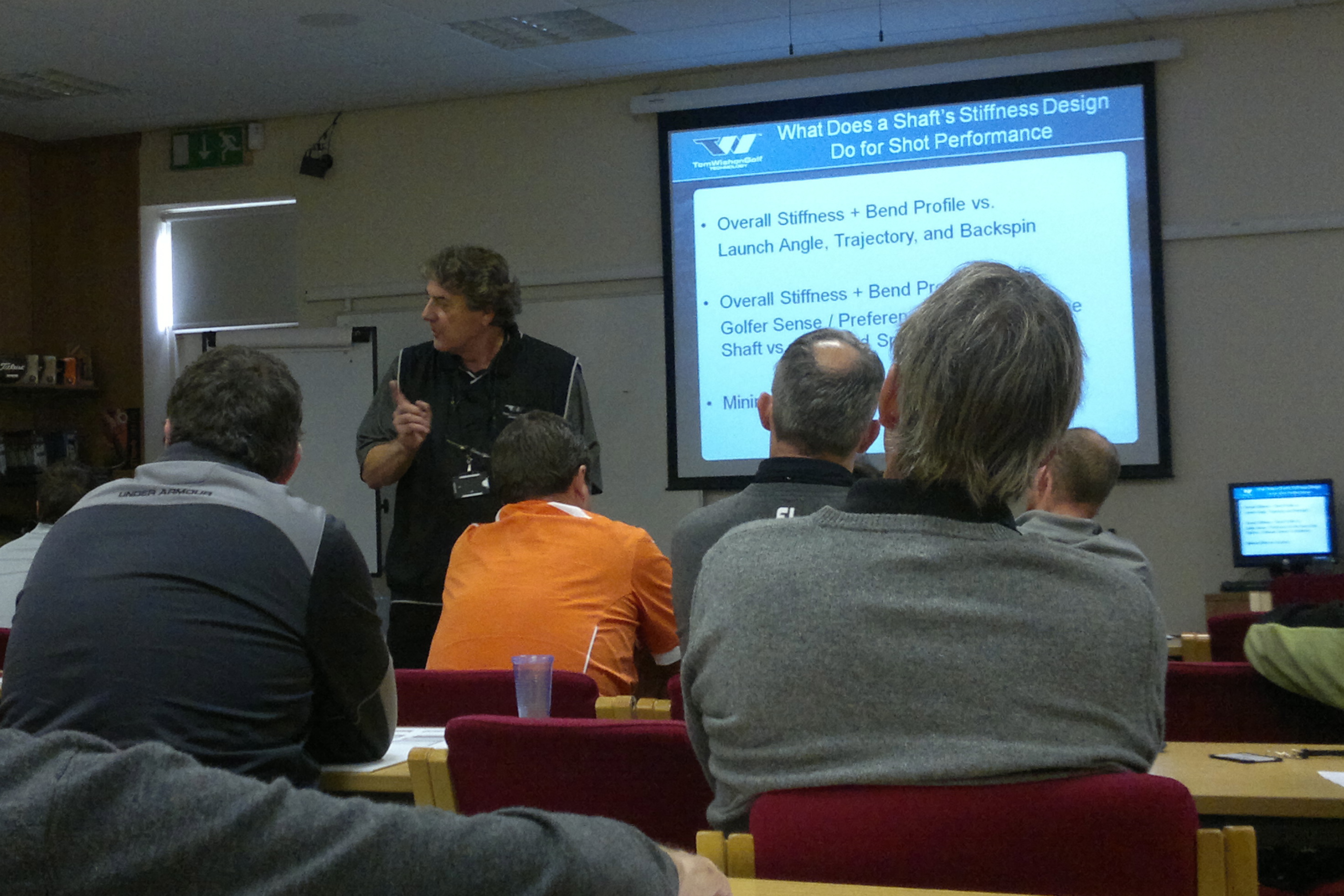
There is no question the shaft is the least understood of all the components of a golf club.
The first reason is because most golfers simply do not know what the shaft can and cannot do to influence the outcome of a shot. Second, many golfers think that the shaft does what it does for every golfer who uses that shaft. It is very common for a golfer to switch shafts, see a visible change in ball flight, and attribute all of the shot change they see to the shaft. In reality, there are other fitting parameters in the club that underwent a significant change when the new shaft was installed, which may or may not be the reason for the change in ball flight.
In Part 1 and Part 2 of my series on shafts, you have learned how it is possible to measure and express a shaft’s flex and bend profile design in quantitative terms. The graphs and stiffness measurement data take flex and bend profile comparison and selection to the same level of quantitative measurement as all the other specs of the golf club which are measured in degrees, grams and inches.
But in the end, even with the ability to empirically compare shaft flex and bend profile, there are still questions:
- How does the shaft contribute to ball flight?
- For who does it contribute?
- How much does it contribute?
- How does it actually contribute?
I’ve spent decades in my career doing this study and I strongly believe that we do know the answers to these often confusing questions about the performance of the shaft.
The shaft can have an effect on launch angle, trajectory and spin rate. How much of an effect the shaft has on these shot parameters depends on the lateness of a golfer’s release, their clubhead speed and how aggressive their downswing tempo is. In addition, how much the shaft can change launch angle, trajectory and spin for golfers who do have the swing characteristics to make the shaft perform depends completely on the overall stiffness and bend profile of the new shaft versus the golfer’s previous shaft.
For those of you who have read some of my articles and posts on shafts, you have heard this part before. The shaft’s effect on launch angle, trajectory and backspin only become visible as the golfer’s release occurs later and later in the downswing. In addition, the shaft’s effect on trajectory and spin progresses more and more as the golfer’s clubhead speed and downswing aggressiveness/force increases.
Golfers who unhinge the wrist cock early to midway in the downswing do NOT experience a difference in launch angle, trajectory or backspin from shafts of different flex and different bend profile. They do experience a difference in how solid or boardy the impact with the ball is. But as the release gets to midway on the downswing, and progressively a little later and later beyond midway in the downswing, the shaft begins to have a little more and more effect on launch angle, trajectory and spin.
The reason the shaft can have an effect on launch angle, trajectory and spin for later release players is because of the way the timing of the bending of the shaft can affect the dynamic loft of the clubhead at impact. When the golfer begins to unhinge their wrist cock angle on the downswing, the golfer’s hands/arms begin to slow down while the club accelerates.
Yes, for EVERY golfer, once he or she unhinges the wrist cock angle, their arms slow down. Because the hands are holding the club while the arms are slowing down, the acceleration of the club begins to push the shaft against the resistance of the slowing arms/hands into a forward bend position.
The later the golfer’s release, the more the forward bending of the shaft can arrive at impact in that forward bend position. For a midway release, the shaft only has a slight amount of forward bend by the time the clubhead gets to the ball. For an early to midway release, the forward bending of the shaft happens too soon, so that by the time the clubhead gets to the ball, the shaft has rebounded back to straight, thus not changing the dynamic loft of the clubhead at impact.
It is important to understand that two golfers can have the same launch angle, but have totally different trajectories and backspin amounts from each other. If two golfers with different clubhead speeds have the same swing path, same angle of attack and same hand position at impact, the launch angle will be the same but the trajectory and spin rates will differ. The higher the clubhead speed of the golfer, the higher the trajectory and spin will be for any given launch angle.
How much can the shaft affect the launch angle and spin rate for those golfers who do have a later to very late release?
Two things control this. First, when a golfer uses a different shaft than he has been playing, the only way the shaft can change the launch angle and spin is if the new shaft is different in its overall stiffness design than the old shaft. Second, how much the shaft can affect launch angle and spin also depends on how flexible or stiff the shaft is in relation to the golfer’s clubhead speed, transition and tempo force and point of release.
First, I see TONS of posts and questions in the GolfWRX forums that say something like:
“I need a recommendation for a good low-launching (or high-launching), low-spin shaft.”
Such a question is asked as if the golfer thinks that a shaft will demonstrate the same effect on launch angle and spin for every golfer who uses it.
While the shaft companies like to say their shafts are designed to have certain launch and spin characteristics, the truth is that a shaft can only offer a low or higher launch/spin if it is stiffer or more flexible THAN WHAT THE GOLFER USED BEFORE.
In other words, what is a low-launch and low-spin shaft for Golfer A can be a high-launch and high-spin shaft for Golfer B, and vice versa. FOR THE SAME SHAFT, the golfer with the higher clubhead speed, later release and more upward angle of attack is going to hit shots with a higher launch, higher trajectory and higher spin than will the golfer with a lower clubhead speed, earlier release and more downward angle of attack.
So, for golfers who are looking for a low-launch, low-spinning shaft, the only way you can find that is to:
- Know precisely what the overall stiffness and bend profile stiffness design is of the shaft you now play, and…
- Know the overall stiffness and bend profile stiffness design of all other shafts so you can pick one that is stiffer overall and/or has a more stiff tip section design.
Shafts are dumb animals. They only do what their owner’s swing forces them to do.
Second, if a late-release golfer were to play with a soft L-Flex shaft one day and a stiff X-Flex the next, without question the difference in launch angle, trajectory and spin would be very significant. But common sense says this isn’t going to happen because each golfer should play a shaft that has its overall stiffness and bend profile properly matched to the golfer’s unique combination of clubhead speed, transition/tempo force and point of wrist cock release.
Sure, some of us prefer to play a shaft that feels stiffer. Some of us like to play a shaft that feels a little more flexible. If a golfer has a preferred sense of bending feel for a shaft, without question, regardless of their clubhead speed, transition/tempo and point of release, their best shaft has to satisfy that bending feel preference or their swing tempo/timing/rhythm/release gets screwed up and becomes inconsistent.
But within shafts that reasonably fit a golfer’s clubhead speed, transition/tempo and point of release, typically the maximum difference seen in launch angle from different shaft options is in the area of 2.5-to-3 degrees. As far as spin difference, that depends on the clubhead speed of the golfer. A shaft that launches the ball 2-degrees higher for a golfer with an 80 mph clubhead speed would typically increase spin by 350-to-400 rpm, while a shaft that launches the ball 2-degrees higher for a golfer with a 100 mph clubhead speed would typically increase spin by 500-to-600 rpm – that is, of course, given the same clubhead and same other assembly specs of the club.
So the bottom line is this: shafts can bring about changes in launch angle, trajectory and spin, but only for golfers with a later-to-late release, and only to the extent that their overall stiffness and bend profile are different from the shaft the golfer previously played.
If the golfer has developed a preferred sense of bending feel for the shaft, playing a shaft that satisfies that preferred bending feel will enable the golfer to achieve their highest clubhead speed. However, for such a golfer, playing a shaft that does NOT perfectly match their preferred bending feel will bring about a lower clubhead speed, worse accuracy and more off-center hits.
Here’s a statement about shafts that I have heard a few times in my career:
“Different shaft designs can be designed with a higher tip velocity to allow the golfer to achieve a higher clubhead speed.”
That’s not correct. As I said before, shafts are dumb animals. They ONLY do what the swing characteristics of their owners cause them to do. Whenever a golfer uses a shaft that has its weight, overall stiffness and bend profile well matched to the golfer’s clubhead speed, transition/tempo, point of release AND preference for bending feel, that’s when the golfer will achieve their highest clubhead speed. But this is only if the specs of length, loft, face angle, total weight, swing weight, and grip size are correctly fit to the golfer as well.
Give that same shaft to a different golfer with the same clubhead speed but a different combination of transition/tempo, point of release and preference for bending feel and that same shaft will result in a lower clubhead speed with far worse performance for that golfer BECAUSE THE SHAFT DOES NOT FIT THE SWING CHARACTERISTICS OF THE OTHER GOLFER.
A shaft can only exhibit a high level of “tip velocity” for the golfers whose clubhead speed, transition/tempo, point of release AND preference for bending feel is perfectly matched to the weight, overall stiffness and bend profile of the shaft.
Conclusion
The flex (overall stiffness) and bend profile (distribution of stiffness over the length of the shaft) are without question an important performance element of the golf club – but only to golfers whose point of release is later in the downswing. In addition, the flex and bend profile of the shaft becomes more of a performance element in the shot as the golfer’s clubhead speed gets higher and their transition and tempo gets more aggressive.
So for golfers with an early-to-midway release with a slower swing speed and with a less forceful and aggressive transition and tempo, the shaft’s flex and bend profile will not affect launch angle, trajectory and backspin and become chiefly a contributor to the impact feel of the shot coming off the clubhead.
As always, the very best way to be fit to the best shaft for your swing and for your shot shape requirements is to find a good clubmaker. There are clubmakers out there who really live, eat and breathe the quantitative and swing analysis approach to shaft fitting. If you want the best fitting, see one of these clubmakers and you will be well ahead for doing so.
To find a good Clubmaker in your area, consult any of these following sources:
- The AGCP (Association of Golf Clubfitting Professionals)
- The ICG (International Clubmakers’ Guild)
- The TWGT Clubmaker Locator
Related
Opinion & Analysis
The 2 primary challenges golf equipment companies face

As the editor-in-chief of this website and an observer of the GolfWRX forums and other online golf equipment discourse for over a decade, I’m pretty well attuned to the grunts and grumbles of a significant portion of the golf equipment purchasing spectrum. And before you accuse me of lording above all in some digital ivory tower, I’d like to offer that I worked at golf courses (public and private) for years prior to picking up my pen, so I’m well-versed in the non-degenerate golf equipment consumers out there. I touched (green)grass (retail)!
Complaints about the ills of and related to the OEMs usually follow some version of: Product cycles are too short for real innovation, tour equipment isn’t the same as retail (which is largely not true, by the way), too much is invested in marketing and not enough in R&D, top staffer X hasn’t even put the new driver in play, so it’s obviously not superior to the previous generation, prices are too high, and on and on.
Without digging into the merits of any of these claims, which I believe are mostly red herrings, I’d like to bring into view of our rangefinder what I believe to be the two primary difficulties golf equipment companies face.
One: As Terry Koehler, back when he was the CEO of Ben Hogan, told me at the time of the Ft Worth irons launch, if you can’t regularly hit the golf ball in a coin-sized area in the middle of the face, there’s not a ton that iron technology can do for you. Now, this is less true now with respect to irons than when he said it, and is less and less true by degrees as the clubs get larger (utilities, fairways, hybrids, drivers), but there remains a great deal of golf equipment truth in that statement. Think about it — which is to say, in TL;DR fashion, get lessons from a qualified instructor who will teach you about the fundamentals of repeatable impact and how the golf swing works, not just offer band-aid fixes. If you can’t repeatably deliver the golf club to the golf ball in something resembling the manner it was designed for, how can you expect to be getting the most out of the club — put another way, the maximum value from your investment?
Similarly, game improvement equipment can only improve your game if you game it. In other words, get fit for the clubs you ought to be playing rather than filling the bag with the ones you wish you could hit or used to be able to hit. Of course, don’t do this if you don’t care about performance and just want to hit a forged blade while playing off an 18 handicap. That’s absolutely fine. There were plenty of members in clubs back in the day playing Hogan Apex or Mizuno MP-32 irons who had no business doing so from a ballstriking standpoint, but they enjoyed their look, feel, and complementary qualities to their Gatsby hats and cashmere sweaters. Do what brings you a measure of joy in this maddening game.
Now, the second issue. This is not a plea for non-conforming equipment; rather, it is a statement of fact. USGA/R&A limits on every facet of golf equipment are detrimental to golf equipment manufacturers. Sure, you know this, but do you think about it as it applies to almost every element of equipment? A 500cc driver would be inherently more forgiving than a 460cc, as one with a COR measurement in excess of 0.83. 50-inch shafts. Box grooves. And on and on.
Would fewer regulations be objectively bad for the game? Would this erode its soul? Fortunately, that’s beside the point of this exercise, which is merely to point out the facts. The fact, in this case, is that equipment restrictions and regulations are the slaughterbench of an abundance of innovation in the golf equipment space. Is this for the best? Well, now I’ve asked the question twice and might as well give a partial response, I guess my answer to that would be, “It depends on what type of golf you’re playing and who you’re playing it with.”
For my part, I don’t mind embarrassing myself with vintage blades and persimmons chasing after the quasi-spiritual elevation of a well-struck shot, but that’s just me. Plenty of folks don’t give a damn if their grooves are conforming. Plenty of folks think the folks in Liberty Corner ought to add a prison to the museum for such offences. And those are just a few of the considerations for the amateur game — which doesn’t get inside the gallery ropes of the pro game…
Different strokes in the game of golf, in my humble opinion.
Anyway, I believe equipment company engineers are genuinely trying to build better equipment year over year. The marketing departments are trying to find ways to make this equipment appeal to the broadest segment of the golf market possible. All of this against (1) the backdrop of — at least for now — firm product cycles. And golfers who, with their ~15 average handicap (men), for the most part, are not striping the golf ball like Tiger in his prime and seem to have less and less time year over year to practice and improve. (2) Regulations that massively restrict what they’re able to do…
That’s the landscape as I see it and the real headwinds for golf equipment companies. No doubt, there’s more I haven’t considered, but I think the previous is a better — and better faith — point of departure when formulating any serious commentary on the golf equipment world than some of the more cynical and conspiratorial takes I hear.
Agree? Disagree? Think I’m worthy of an Adam Hadwin-esque security guard tackle? Let me know in the comments.
@golfoncbs The infamous Adam Hadwin tackle ? #golf #fyp #canada #pgatour #adamhadwin ? Ghibli-style nostalgic waltz – MaSssuguMusic
Podcasts
Fore Love of Golf: Introducing a new club concept

Episode #16 brings us Cliff McKinney. Cliff is the founder of Old Charlie Golf Club, a new club, and concept, to be built in the Florida panhandle. The model is quite interesting and aims to make great, private golf more affordable. We hope you enjoy the show!
Opinion & Analysis
On Scottie Scheffler wondering ‘What’s the point of winning?’

Last week, I came across a reel from BBC Sport on Instagram featuring Scottie Scheffler speaking to the media ahead of The Open at Royal Portrush. In it, he shared that he often wonders what the point is of wanting to win tournaments so badly — especially when he knows, deep down, that it doesn’t lead to a truly fulfilling life.
View this post on Instagram
“Is it great to be able to win tournaments and to accomplish the things I have in the game of golf? Yeah, it brings tears to my eyes just to think about it because I’ve literally worked my entire life to be good at this sport,” Scheffler said. “To have that kind of sense of accomplishment, I think, is a pretty cool feeling. To get to live out your dreams is very special, but at the end of the day, I’m not out here to inspire the next generation of golfers. I’m not out here to inspire someone to be the best player in the world, because what’s the point?”
Ironically — or perhaps perfectly — he went on to win the claret jug.
That question — what’s the point of winning? — cuts straight to the heart of the human journey.
As someone who’s spent over two decades in the trenches of professional golf, and in deep study of the mental, emotional, and spiritual dimensions of the game, I see Scottie’s inner conflict as a sign of soul evolution in motion.
I came to golf late. I wasn’t a junior standout or college All-American. At 27, I left a steady corporate job to see if I could be on the PGA Tour starting as a 14-handicap, average-length hitter. Over the years, my journey has been defined less by trophies and more by the relentless effort to navigate the deeply inequitable and gated system of professional golf — an effort that ultimately turned inward and helped me evolve as both a golfer and a person.
One perspective that helped me make sense of this inner dissonance around competition and our culture’s tendency to overvalue winning is the idea of soul evolution.
The University of Virginia’s Division of Perceptual Studies has done extensive research on reincarnation, and Netflix’s Surviving Death (Episode 6) explores the topic, too. Whether you take it literally or metaphorically, the idea that we’re on a long arc of growth — from beginner to sage elder — offers a profound perspective.
If you accept the premise literally, then terms like “young soul” and “old soul” start to hold meaning. However, even if we set the word “soul” aside, it’s easy to see that different levels of life experience produce different worldviews.
Newer souls — or people in earlier stages of their development — may be curious and kind but still lack discernment or depth. There is a naivety, and they don’t yet question as deeply, tending to see things in black and white, partly because certainty feels safer than confronting the unknown.
As we gain more experience, we begin to experiment. We test limits. We chase extreme external goals — sometimes at the expense of health, relationships, or inner peace — still operating from hunger, ambition, and the fragility of the ego.
It’s a necessary stage, but often a turbulent and unfulfilling one.
David Duval fell off the map after reaching World No. 1. Bubba Watson had his own “Is this it?” moment with his caddie, Ted Scott, after winning the Masters.
In Aaron Rodgers: Enigma, reflecting on his 2011 Super Bowl win, Rodgers said:
“Now I’ve accomplished the only thing that I really, really wanted to do in my life. Now what? I was like, ‘Did I aim at the wrong thing? Did I spend too much time thinking about stuff that ultimately doesn’t give you true happiness?’”
Jim Carrey once said, “I think everybody should get rich and famous and do everything they ever dreamed of so they can see that it’s not the answer.”
Eventually, though, something shifts.
We begin to see in shades of gray. Winning, dominating, accumulating—these pursuits lose their shine. The rewards feel more fleeting. Living in a constant state of fight-or-flight makes us feel alive, yes, but not happy and joyful.
Compassion begins to replace ambition. Love, presence, and gratitude become more fulfilling than status, profits, or trophies. We crave balance over burnout. Collaboration over competition. Meaning over metrics.
Interestingly, if we zoom out, we can apply this same model to nations and cultures. Countries, like people, have a collective “soul stage” made up of the individuals within them.
Take the United States, for example. I’d place it as a mid-level soul: highly competitive and deeply driven, but still learning emotional maturity. Still uncomfortable with nuance. Still believing that more is always better. Despite its global wins, the U.S. currently ranks just 23rd in happiness (as of 2025). You might liken it to a gifted teenager—bold, eager, and ambitious, but angsty and still figuring out how to live well and in balance. As much as a parent wants to protect their child, sometimes the child has to make their own mistakes to truly grow.
So when Scottie Scheffler wonders what the point of winning is, I don’t see someone losing strength.
I see someone evolving.
He’s beginning to look beyond the leaderboard. Beyond metrics of success that carry a lower vibration. And yet, in a poetic twist, Scheffler did go on to win The Open. But that only reinforces the point: even at the pinnacle, the question remains. And if more of us in the golf and sports world — and in U.S. culture at large — started asking similar questions, we might discover that the more meaningful trophy isn’t about accumulating or beating others at all costs.
It’s about awakening and evolving to something more than winning could ever promise.



